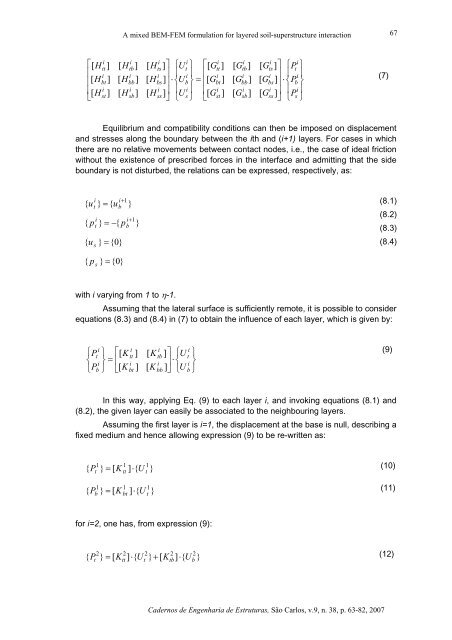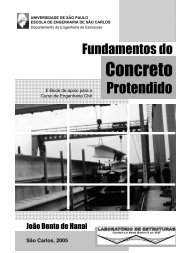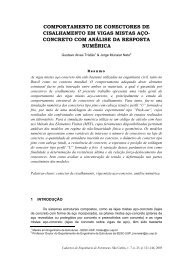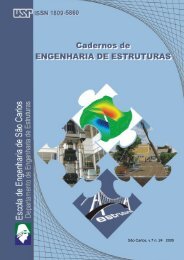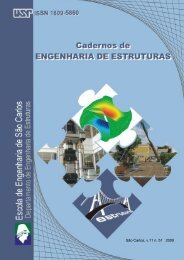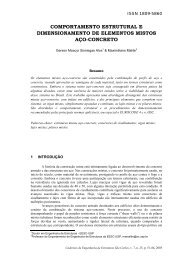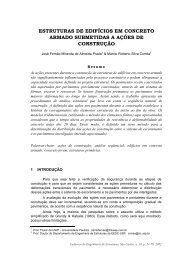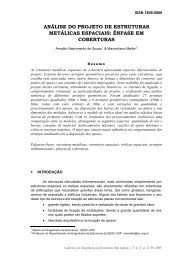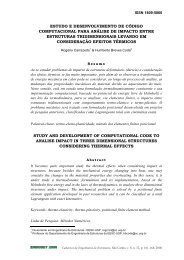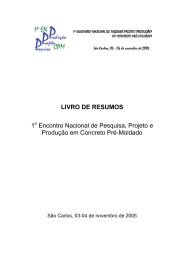download completo - SET - USP
download completo - SET - USP
download completo - SET - USP
You also want an ePaper? Increase the reach of your titles
YUMPU automatically turns print PDFs into web optimized ePapers that Google loves.
A mixed BEM-FEM formulation for layered soil-superstructure interaction<br />
67<br />
⎡[<br />
H<br />
⎢<br />
⎢[<br />
H<br />
⎢<br />
⎣<br />
[ H<br />
i<br />
tt<br />
i<br />
bt<br />
i<br />
st<br />
]<br />
]<br />
]<br />
[ H<br />
[ H<br />
[ H<br />
i<br />
tb<br />
i<br />
bb<br />
i<br />
sb<br />
]<br />
]<br />
]<br />
[ H<br />
[ H<br />
[ H<br />
i<br />
ts<br />
i<br />
bs<br />
i<br />
ss<br />
] ⎤ ⎧U<br />
⎥ ⎪<br />
] ⎥ ⋅ ⎨U<br />
] ⎥ ⎪<br />
⎦ ⎩<br />
U<br />
i<br />
t<br />
i<br />
b<br />
i<br />
s<br />
⎫ ⎡<br />
i<br />
[ Gtt<br />
]<br />
⎪ ⎢ i<br />
⎬ = ⎢[<br />
Gbt<br />
]<br />
⎪ ⎢ i<br />
⎭ ⎣<br />
[ Gst<br />
]<br />
[ G<br />
[ G<br />
[ G<br />
i<br />
tb<br />
i<br />
bb<br />
i<br />
sb<br />
]<br />
]<br />
]<br />
i<br />
⎤ ⎧<br />
i<br />
[ G ⎫<br />
ts]<br />
Pt<br />
i ⎥ ⎪ i ⎪<br />
[ Gbs]<br />
⎥ ⋅ ⎨Pb<br />
⎬<br />
i ⎥ ⎪ i<br />
[ G ⎪<br />
ss]<br />
⎦ ⎩<br />
Ps<br />
⎭<br />
(7)<br />
Equilibrium and compatibility conditions can then be imposed on displacement<br />
and stresses along the boundary between the ith and (i+1) layers. For cases in which<br />
there are no relative movements between contact nodes, i.e., the case of ideal friction<br />
without the existence of prescribed forces in the interface and admitting that the side<br />
boundary is not disturbed, the relations can be expressed, respectively, as:<br />
{ u<br />
i<br />
t<br />
{ p<br />
} = { u<br />
i<br />
t<br />
i+1<br />
b<br />
} = −{<br />
p<br />
{ u } = {0}<br />
s<br />
}<br />
i+1<br />
b<br />
}<br />
(8.1)<br />
(8.2)<br />
(8.3)<br />
(8.4)<br />
{ p } = {0}<br />
s<br />
with i varying from 1 to η-1.<br />
Assuming that the lateral surface is sufficiently remote, it is possible to consider<br />
equations (8.3) and (8.4) in (7) to obtain the influence of each layer, which is given by:<br />
⎧<br />
i<br />
Pt<br />
⎨ i<br />
⎩Pb<br />
⎫ ⎡[<br />
K<br />
⎬ = ⎢<br />
⎭ ⎣[<br />
K<br />
i<br />
tt<br />
i<br />
bt<br />
]<br />
]<br />
[ K<br />
[ K<br />
i<br />
tb<br />
i<br />
bb<br />
] ⎤ ⎧U<br />
⎥ ⋅ ⎨<br />
] ⎦ ⎩U<br />
i<br />
t<br />
i<br />
b<br />
⎫<br />
⎬<br />
⎭<br />
(9)<br />
In this way, applying Eq. (9) to each layer i, and invoking equations (8.1) and<br />
(8.2), the given layer can easily be associated to the neighbouring layers.<br />
Assuming the first layer is i=1, the displacement at the base is null, describing a<br />
fixed medium and hence allowing expression (9) to be re-written as:<br />
1<br />
t<br />
{ P<br />
1<br />
b<br />
{ P<br />
1 1<br />
} = [ K ] ⋅{<br />
U }<br />
(10)<br />
tt<br />
t<br />
1 1<br />
} = [ K ] ⋅{<br />
U }<br />
(11)<br />
bt<br />
t<br />
for i=2, one has, from expression (9):<br />
2<br />
t<br />
{ P<br />
2 2 2 2<br />
} = [ K ] ⋅{<br />
U } + [ K ] ⋅{<br />
U }<br />
(12)<br />
tt<br />
t<br />
tb<br />
b<br />
Cadernos de Engenharia de Estruturas, São Carlos, v.9, n. 38, p. 63-82, 2007



